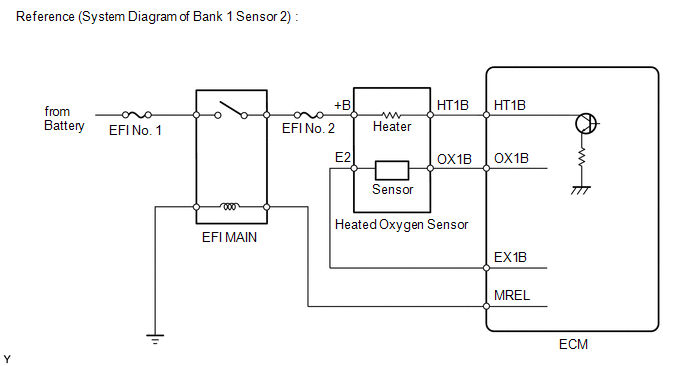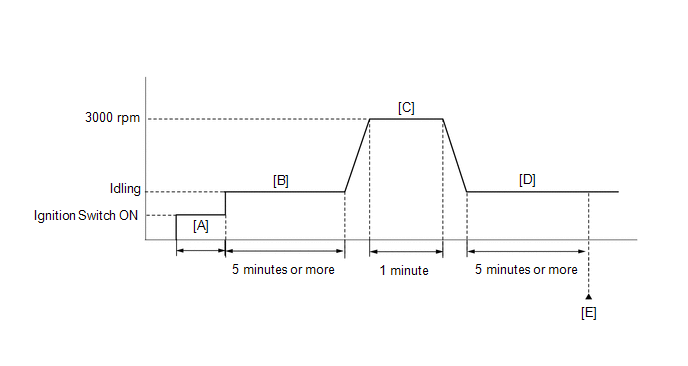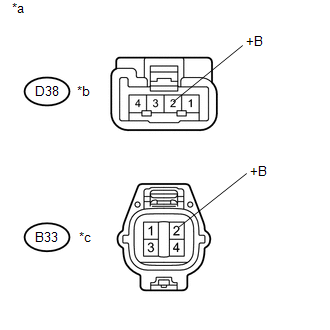- Open in heated oxygen sensor heater (bank 1, 2 sensor 2) circuit
- Heated oxygen sensor heater (bank 1, 2 sensor 2)
- ECM
| Last Modified: 08-28-2024 | 6.11:8.1.0 | Doc ID: RM100000000VIAJ |
| Model Year Start: 2016 | Model: Sienna | Prod Date Range: [12/2015 - 08/2016] |
| Title: 2GR-FE (ENGINE CONTROL): SFI SYSTEM: P0037,P0038,P0057,P0058,P0141,P0161,P102D,P105D; Oxygen Sensor Heater Control Circuit Low (Bank 1 Sensor 2); 2016 MY Sienna [12/2015 - 08/2016] | ||
|
DTC |
P0037 |
Oxygen Sensor Heater Control Circuit Low (Bank 1 Sensor 2) |
|
DTC |
P0038 |
Oxygen Sensor Heater Control Circuit High (Bank 1 Sensor 2) |
|
DTC |
P0057 |
Oxygen Sensor Heater Control Circuit Low (Bank 2 Sensor 2) |
|
DTC |
P0058 |
Oxygen Sensor Heater Control Circuit High (Bank 2 Sensor 2) |
|
DTC |
P0141 |
Oxygen Sensor Heater Circuit (Bank 1 Sensor 2) |
|
DTC |
P0161 |
Oxygen Sensor Heater Circuit (Bank 2 Sensor 2) |
|
DTC |
P102D |
O2 Sensor Heater Circuit Performance Bank 1 Sensor 2 Stuck ON |
|
DTC |
P105D |
O2 Sensor Heater Circuit Performance Bank 2 Sensor 2 Stuck ON |
DESCRIPTION
A three-way catalytic converter is used in order to convert the carbon monoxide (CO), hydrocarbons (HC), and nitrogen oxides (NOx) into less harmful substances. To allow the three-way catalytic converter to function effectively, it is necessary to keep the air fuel ratio of the engine near the stoichiometric air fuel ratio. For the purpose of helping the ECM to deliver accurate air fuel ratio control, a heated oxygen sensor is used.
The heated oxygen sensor is located behind the three-way catalytic converter, and detects the oxygen concentration in the exhaust gas. Since the sensor is integrated with the heater that heats the sensing portion, it is possible to detect the oxygen concentration even when the intake air volume is low (the exhaust gas temperature is low).
When the air fuel ratio becomes lean, the oxygen concentration in the exhaust gas becomes rich. The heated oxygen sensor informs the ECM that the post-three-way catalytic converter air fuel ratio is lean (low voltage, i.e. less than 0.45 V).
Conversely, when the air fuel ratio is richer than the stoichiometric air fuel level, the oxygen concentration in the exhaust gas becomes lean. The heated oxygen sensor informs the ECM that the post-three-way catalytic converter air fuel ratio is rich (high voltage, i.e. more than 0.45 V). The heated oxygen sensor has the property of changing its output voltage drastically when the air fuel ratio is close to the stoichiometric level.
The ECM uses the supplementary information from the heated oxygen sensor to determine whether the air fuel ratio after the three-way catalytic converter is rich or lean, and adjusts the fuel injection time accordingly. Thus, if the heated oxygen sensor is working improperly due to internal malfunctions, the ECM is unable to compensate for deviations in the primary air fuel ratio control.

HINT:
- Sensor 2 refers to the sensor mounted behind the three-way catalytic converter and located far from the engine assembly.
- When any of these DTCs are stored, the ECM enters fail-safe mode. The ECM turns off the heated oxygen sensor heater in fail-safe mode. Fail-safe mode continues until the ignition switch is turned off.
-
The ECM provides a pulse width modulated control circuit to adjust the current through the heater. The heated oxygen sensor heater circuit uses a relay on the +B side of the circuit.

|
DTC No. |
DTC Detection Condition |
Trouble Area |
|---|---|---|
|
P0037 P0057 |
Heated oxygen sensor heater (bank 1, 2 sensor 2) current is less than 0.3 A (1 trip detection logic) |
|
|
P0038 P0058 |
Heated oxygen sensor heater (bank 1, 2 sensor 2) current fail (1 trip detection logic) |
|
|
P0141 P0161 |
Cumulative heater resistance correction value exceeds the acceptable threshold (2 trip detection logic) |
|
|
P102D P105D |
Heated oxygen sensor heater current is higher than the specified value while the heater is not operating (1 trip detection logic) |
ECM |
MONITOR DESCRIPTION
The sensing portion of the heated oxygen sensor has a zirconia element which is used to detect the oxygen concentration in the exhaust gas. If the zirconia element is at the appropriate temperature, and the difference between the oxygen concentrations surrounding the inside and outside surfaces of the sensor is large, the zirconia element generates voltage signals. In order to increase the oxygen concentration detecting capacity of the zirconia element, the ECM supplements the heat from the exhaust with heat from a heating element inside the sensor.
Heated Oxygen Sensor Heater Range Check (P0037, P0038, P0057, P0058, P102D and P105D):
- The ECM monitors the current applied to the heated oxygen sensor heater to check the heater for malfunctions. If the heater current is outside the normal range, the signal transmitted by the heated oxygen sensor becomes inaccurate. When the current in the heated oxygen sensor heater is outside the normal operating range, the ECM interprets this as a malfunction in the sensor and stores a DTC.
Heated Oxygen Sensor Heater Performance (P0141 and P0161):
- After the accumulated heater on time exceeds 100 seconds, the ECM calculates the heater resistance using the battery voltage and the current applied to the heater. If the resistance is above the threshold value, the ECM will determine that there is a malfunction in the heated oxygen sensor heater and store DTCs P0141 and P0161.
MONITOR STRATEGY
|
Related DTCs |
P0037: Heated oxygen sensor heater (bank 1 sensor 2) range check (Low electrical current) P0038: Heated oxygen sensor heater (bank 1 sensor 2) range check (High electrical current) P0057: Heated oxygen sensor heater (bank 2 sensor 2) range check (Low electrical current) P0058: Heated oxygen sensor heater (bank 2 sensor 2) range check (High electrical current) P0141: Heated oxygen sensor heater (bank 1 sensor 2) performance P0161: Heated oxygen sensor heater (bank 2 sensor 2) performance P102D: Heated oxygen sensor (bank 1 sensor 2) performance P105D: Heated oxygen sensor (bank 2 sensor 2) performance |
|
Required sensors/Components (Main) |
Heated oxygen sensor heater |
|
Required sensors/Components (Related) |
- |
|
Frequency of operation |
Continuous: P0037, P0038, P0057, P0058, P102D and P105D Once per driving cycle: P0141 and P0161 |
|
Duration |
0.5 seconds: P0037, P0057, P102D and P105D Within 3 seconds: P0038 and P0058 10 seconds: P0141 and P0161 |
|
MIL operation |
Immediately: P0037, P0038, P0057, P0058, P102D and P105D 2 driving cycles: P0141 and P0161 |
|
Sequence of operation |
None |
TYPICAL ENABLING CONDITIONS
All
|
Monitor runs whenever following DTCs are not stored |
None |
P0037 and P0057 (Case 1)
|
All of the following conditions are met |
- |
|
Battery voltage |
10.5 V or higher |
|
Engine |
Running |
|
Starter |
Off |
|
Catalyst active air fuel ratio control |
Not operating |
|
Time after heater on |
10 seconds or more |
|
Learned heater off current operation |
Completed |
|
Learned heater off current operation |
Succeeded |
|
Oxygen sensor heater high current fail (P0038, P0058) |
Not detected |
|
Heater on current - Learned heater off current |
0.3 A or less |
|
Command to heater output |
ON |
P0037 and P0057 (Case 2)
|
All of the following conditions are met |
- |
|
Battery voltage |
10.5 V or higher |
|
Engine |
Running |
|
Starter |
OFF |
|
Catalyst active air fuel ratio control |
Not operating |
|
Time after heater on |
10 seconds or more |
|
Learned heater off current operation |
Completed |
|
Heater off current |
More than 3.5 A |
|
Heater current detected by heater monitor IC |
4 A or more |
|
Oxygen sensor heater high current fail (P0038 P0058) |
Not detected |
P0038 and P0058
|
All of the following conditions are met |
- |
|
Battery voltage |
10.5 V or higher |
|
Engine |
Running |
|
Starter |
OFF |
|
Catalyst active air fuel ratio control |
Not operating |
|
Time after heater on |
10 seconds or more |
|
Learned heater off current operation |
Completed |
P0141 and P0161
|
All of the following conditions are met |
- |
|
Oxygen sensor heater circuit fail (P0037, P0038, P0057, P0058, P102D and P105D) |
Not detected |
|
Battery voltage |
10.5 V or higher |
|
Fuel cut |
OFF |
|
Time after fuel cut on to off |
30 seconds or more |
|
Accumulated heater on time |
100 seconds or more |
|
Learned heater off current operation |
Completed |
|
Duration that rear heated oxygen sensor impedance is less than 15 kΩ |
2 seconds or more |
P102D and P105D
|
All of the following conditions are met |
- |
|
Battery voltage |
10.5 V or higher |
|
Engine |
Running |
|
Starter |
OFF |
|
Catalyst active air fuel ratio control |
Not operating |
|
Time after heater on |
10 seconds or more |
|
Learned heater off current operation |
Completed |
|
Oxygen sensor heater low current fail (P0037, P0057) |
Not detected |
|
Oxygen sensor heater high current fail (P0038, P0058) |
Not detected |
TYPICAL MALFUNCTION THRESHOLDS
P0037 and P0057 (Case 1)
|
Heater on current - learned heater off current |
0.3 A or less |
P0037 and P0057 (Case 2)
|
Heater on current |
1 A or less |
P0038 and P0058
|
All of the following conditions are met |
- |
|
Heater current detected by heater monitor IC |
4 A or more |
|
Command to heater output |
ON |
P0141 and P0161
|
Heater resistance |
Varies with sensor element temperature (Example: Higher than 23 Ω) |
P102D and P105D
|
Heater on current |
More than 1 A |
CONFIRMATION DRIVING PATTERN

- Connect the Techstream to the DLC3.
- Turn the ignition switch to ON and turn the Techstream on.
-
Clear the DTCs (even if no DTCs are stored, perform the clear DTC procedure) (See page
![2016 MY Sienna [12/2015 - 08/2016]; 2GR-FE (ENGINE CONTROL): SFI SYSTEM: DTC CHECK / CLEAR](/t3Portal/stylegraphics/info.gif) ).
).
- Turn the ignition switch off and wait for at least 30 seconds.
- Turn the ignition switch to ON and turn the Techstream on [A].
- Start the engine and idle it for 5 minutes or more [B].
- With the vehicle stationary, depress the accelerator pedal and maintain an engine speed of 3000 rpm for 1 minute [C].
- Idle the engine for 5 minutes or more [D].
- Enter the following menus: Powertrain / Engine / Trouble Codes [E].
-
Read pending DTCs.
HINT:
- If a pending DTC is output, the system is malfunctioning.
- If a pending DTC is not output, perform the following procedure.
- Enter the following menus: Powertrain / Engine / Utility / All Readiness.
- Input the DTC: P0037, P0038, P0057, P0058, P102D or P105D.
-
Check the DTC judgment result.
Techstream Display
Description
NORMAL
- DTC judgment completed
- System normal
ABNORMAL
- DTC judgment completed
- System abnormal
INCOMPLETE
- DTC judgment not completed
- Perform driving pattern after confirming DTC enabling conditions
N/A
- Unable to perform DTC judgment
- Number of DTCs which do not fulfill DTC preconditions has reached ECU memory limit
- If the judgment result shows INCOMPLETE or N/A, perform steps [B] through [E] again.
-
If no pending DTC is output, perform a universal trip and check for permanent DTCs (See page
![2016 MY Sienna [12/2015 - 08/2016]; 2GR-FE (ENGINE CONTROL): SFI SYSTEM: DTC CHECK / CLEAR](/t3Portal/stylegraphics/info.gif) ).
).
HINT:
- If a permanent DTC is output, the system is malfunctioning.
- If no permanent DTC is output, the system is normal.
WIRING DIAGRAM
Refer to DTC P0136 (See page
![2016 MY Sienna [12/2015 - 08/2016]; 2GR-FE (ENGINE CONTROL): SFI SYSTEM: P0136-P0139,P013A,P013C,P0156-P0159; Oxygen Sensor Circuit (Bank 1 Sensor 2)+](/t3Portal/stylegraphics/info.gif) ).
).
CAUTION / NOTICE / HINT
NOTICE:
Inspect the fuses for circuits related to this system before performing the following inspection procedure.
HINT:
- Read freeze frame data using the Techstream. The ECM records vehicle and driving condition information as freeze frame data the moment a DTC is stored. When troubleshooting, freeze frame data can help determine if the vehicle was moving or stationary, if the engine was warmed up or not, if the air fuel ratio was lean or rich, and other data from the time the malfunction occurred.
-
Bank 1 refers to the bank that includes the No. 1 cylinder*.
*: The No. 1 cylinder is the cylinder which is farthest from the transaxle.
- Bank 2 refers to the bank that does not include the No. 1 cylinder.
- Sensor 1 refers to the sensor closest to the engine assembly.
- Sensor 2 refers to the sensor farthest away from the engine assembly.
- Change the fuel injection volume using the Control the Injection Volume function provided in the Active Test and monitor the heated oxygen sensor output voltage (See page ES-228). If the sensor output voltage does not change (almost no reaction) while performing the Active Test, the sensor may be malfunctioning.
PROCEDURE
|
1. |
INSPECT HEATED OXYGEN SENSOR (HEATER RESISTANCE) |
(a) Inspect the heated oxygen sensor (See page
![2016 MY Sienna [12/2015 - 08/2016]; 2GR-FE (ENGINE CONTROL): HEATED OXYGEN SENSOR: INSPECTION](/t3Portal/stylegraphics/info.gif) ).
).
HINT:
Perform "Inspection After Repair" after replacing the heated oxygen sensor (See page
![2016 MY Sienna [12/2015 - 08/2016]; 2GR-FE (ENGINE CONTROL): SFI SYSTEM: INITIALIZATION](/t3Portal/stylegraphics/info.gif) ).
).
| NG |

|
|
|
2. |
CHECK TERMINAL VOLTAGE (+B OF HEATED OXYGEN SENSOR) |
|
(a) Disconnect the heated oxygen sensor connector. |
|
(b) Turn the ignition switch to ON.
(c) Measure the voltage according to the value(s) in the table below.
Standard Voltage:
|
Tester Connection |
Switch Condition |
Specified Condition |
|---|---|---|
|
D38-2 (+B) - Body ground |
Ignition switch ON |
11 to 14 V |
|
B33-2 (+B) - Body ground |
Ignition switch ON |
11 to 14 V |
Text in Illustration
|
*a |
Front view of wire harness connector (to Heated Oxygen Sensor) |
|
*b |
for bank 1 |
|
*c |
for bank 2 |
| NG |

|
|
|
3. |
CHECK HARNESS AND CONNECTOR (HEATED OXYGEN SENSOR - ECM) |
(a) Disconnect the D38 and B33 heated oxygen sensor connector.
(b) Disconnect the B1 ECM connector.
(c) Measure the resistance according to the value(s) in the table below.
Standard Resistance:
|
Tester Connection |
Condition |
Specified Condition |
|---|---|---|
|
D38-1 (HT1B) - B1-45 (HT1B) |
Always |
Below 1 Ω |
|
B33-1 (HT2B) - B1-44 (HT2B) |
Always |
Below 1 Ω |
|
D38-1 (HT1B) or B1-45 (HT1B) - Body ground |
Always |
10 kΩ or higher |
|
B33-1 (HT2B) or B1-44 (HT2B) - Body ground |
Always |
10 kΩ or higher |
| NG |

|
REPAIR OR REPLACE HARNESS OR CONNECTOR |
|
|
4. |
CHECK WHETHER DTC OUTPUT RECURS (P0037, P0038, P0057, P0058, P0141, P0161, P102D OR P105D) |
(a) Connect the Techstream to the DLC3.
(b) Turn the ignition switch to ON.
(c) Turn the Techstream on.
(d) Clear the DTCs (See page
![2016 MY Sienna [12/2015 - 08/2016]; 2GR-FE (ENGINE CONTROL): SFI SYSTEM: DTC CHECK / CLEAR](/t3Portal/stylegraphics/info.gif) ).
).
(e) Turn the ignition switch off and wait for at least 30 seconds.
(f) Turn the ignition switch to ON.
(g) Turn the Techstream on.
(h) Start the engine.
(i) Drive the vehicle in accordance with the driving pattern described in Confirmation Driving Pattern.
(j) Enter the following menus: Powertrain / Engine / Trouble Codes.
(k) Read the pending DTCs.
Result
|
Result |
Proceed to |
|---|---|
|
DTC is not output |
A |
|
DTC P0037, P0038, P0057, P0058, P0141, P0161, P102D or P105D is output |
B |
| A |

|
| B |

|
|
5. |
INSPECT EFI MAIN RELAY |
(a) Inspect the EFI MAIN relay (See page
![2016 MY Sienna [12/2015 - 08/2016]; 2GR-FE (ENGINE CONTROL): RELAY: ON-VEHICLE INSPECTION+](/t3Portal/stylegraphics/info.gif) ).
).
| NG |

|
REPLACE EFI MAIN RELAY |
|
|
6. |
CHECK HARNESS AND CONNECTOR (HEATED OXYGEN SENSOR - EFI MAIN RELAY) |
(a) Disconnect the D38 and B33 heated oxygen sensor connector.
(b) Remove the EFI MAIN relay from the engine room relay block.
(c) Remove the A/F HTR relay from the engine room relay block.
HINT:
Remove the A/F HTR relay connected between the checked terminals as the coil inside the relay influences the measurement value.
(d) Measure the resistance according to the value(s) in the table below.
Standard Resistance:
|
Tester Connection |
Condition |
Specified Condition |
|---|---|---|
|
D38-2 (+B) - 3 (EFI MAIN relay holder) |
Always |
Below 1 Ω |
|
B33-2 (+B) - 3 (EFI MAIN relay holder) |
Always |
Below 1 Ω |
|
D38-2 (+B) or 3 (EFI MAIN relay holder) - Body ground |
Always |
10 kΩ or higher |
|
B33-2 (+B) or 3 (EFI MAIN relay holder) - Body ground |
Always |
10 kΩ or higher |
| OK |

|
| NG |

|
REPAIR OR REPLACE HARNESS OR CONNECTOR |
|
|
|

